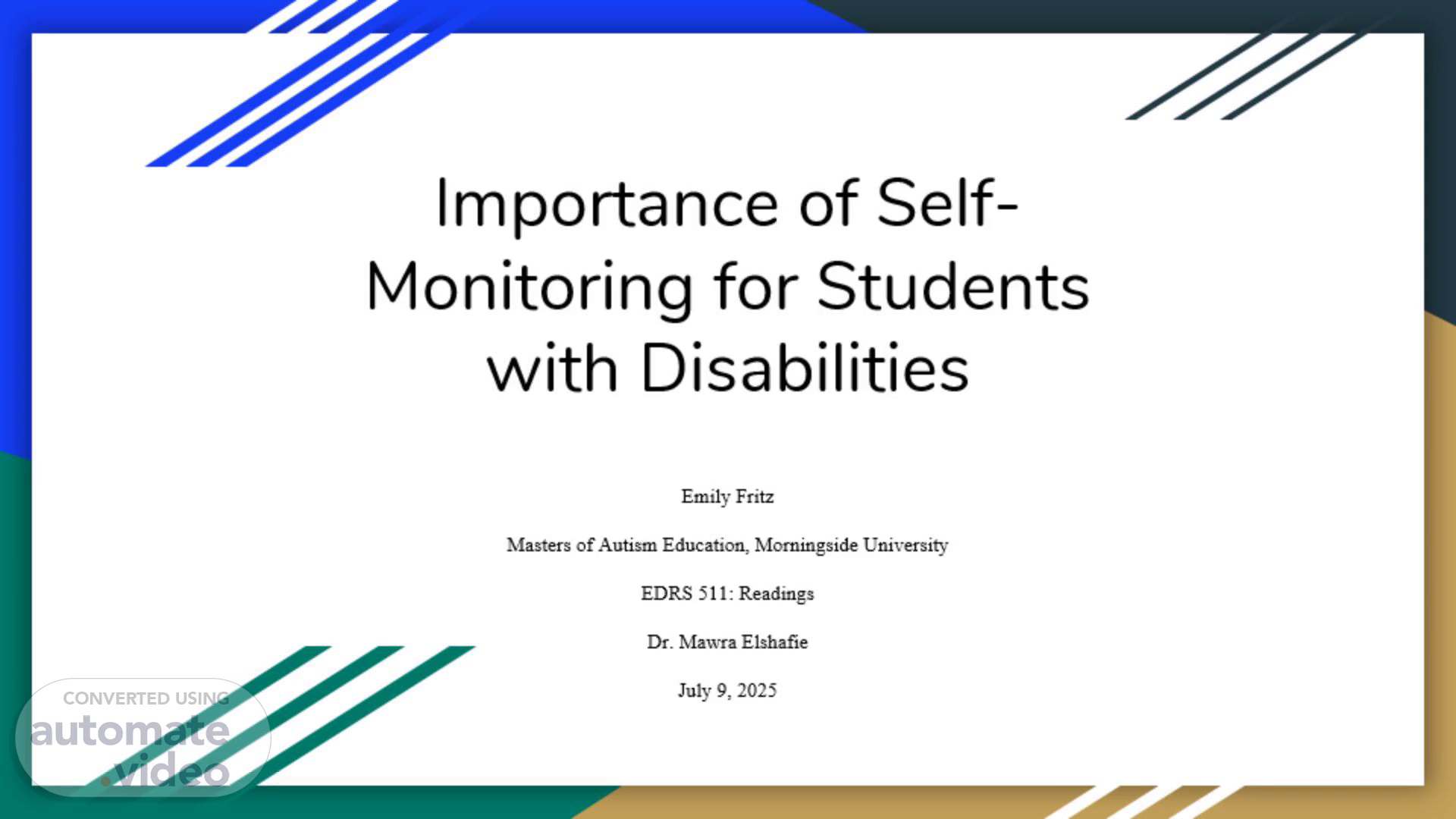
Importance of Self-Monitoring for Students with Disabilities
Scene 1 (0s)
Importance of Self-Monitoring for Students with Disabilities.
Scene 2 (11s)
[Audio] My topic focuses on the use of self-monitoring strategies to improve task completion and motivation in students with disabilities. My thesis is that implementing student-friendly self-monitoring tools, such as goal-tracking charts and self-graphing of data, increases students' awareness of their own progress, fosters motivation, and leads to improved academic performance and independence..
Scene 3 (37s)
[Audio] This topic is significant to me because I work with students who often struggle with staying motivated and completing academic tasks due to the challenges posed by their disabilities. I have seen how a lack of engagement can result in falling behind academically, which in turn affects their self-esteem and future success..
Scene 4 (57s)
[Audio] fostering independence and motivation in students with disabilities is critical for their long-term academic and life outcomes. By helping students develop self-regulation skills, teachers can empower them to take ownership of their learning, which benefits not only the students but also creates a more positive and productive classroom environment..
Scene 5 (1m 19s)
[Audio] background knowledge includes understanding how self-monitoring works as a behavioral intervention strategy, particularly in special education settings. Self-monitoring involves students tracking their own behaviors or academic performance to increase self-awareness and promote desired behaviors. Research has shown (Falkenberg 2013) that when students actively participate in this process, they develop a sense of ownership over their progress, which leads to increased motivation and task completion. Additionally, it's important to recognize the unique challenges students with disabilities face in developing independent work habits..
Scene 6 (1m 59s)
[Audio] Theme 1: Student Motivation Research shows that self-monitoring increases intrinsic motivation by allowing students to see their progress visually and celebrate small wins (Risse, 2023). Students that have no motivation to complete anything shows when students are failing to turn things in which hurts their motivation to accomplish anything (Sipila 2020) Theme 2: Task Completion Study (Falkenberg 2013) indicate that self-monitoring interventions improve rates of homework and in-class task completion among students with disabilities. Supporting students with strategies showed improvement of overall task completion and they were then motivated to work right away to get those tasks done (Payne 2023) Theme 3: Student Ownership and Independence Tools like goal-tracking charts and self-graphing help students take control of their learning and develop critical self-regulation skills (Jasper et al., 2015). When students are taking ownership of their work they can see their progress and it becomes more meaningful as students see their successes right away (Hirsch 2013).
Scene 7 (3m 15s)
[Audio] My research leads me to ask: How does using student friendly goal-tracking charts impact student task completion? And how does self-graphing data influence students' perceptions of their own academic progress? These questions are important because I want to explore how specific self-monitoring tools can be adapted to meet the needs of my students who have disabilities and lead to measurable improvements in their academic success, independence and how well they take ownership of their work..
Scene 8 (3m 45s)
[Audio] The implications of this research suggest that integrating self-monitoring strategies into daily practice can transform the learning experience for students with disabilities. For my own teaching, I plan to consistently use goal-tracking and self-graphing tools to foster accountability and celebrate student progress. Other educators should consider these strategies as they promote independence, enhance student engagement, and potentially reduce behavioral issues linked to academic frustration..
Scene 9 (4m 18s)
[Audio] The next two slides are the resources I have used for my powerpoint and mini lit review..
Scene 10 (5m 23s)
References. Payne, S. B., & Swanson, E. (2023). Supporting families to motivate their middle school student during homework time. Teaching Exceptional Children, 55(6), 422–430. https://doi.org/10.1177/00400599231166792 Risse, M. R., Blair, K. C., & Russo, D. A. (2023). Evaluating technology-based self-monitoring of performance with differential reinforcement for students with disabilities. Behavioral Sciences, 13(1), Article 87. https://doi.org/10.3390/bs 13010087 Rojo, M., Nozari, M., & Bryant, D. P. (2021). Systematic progress monitoring of individualized education program goals in mathematics. Intervention in School and Clinic, 57(5), 322–328. https://doi.org/10.1177/10534512211032616 Rosenbloom, R., Wills, H. P., Mason, R., Huffman, J. M., & Mason, B. A. (2019). The effects of a technology-based self-monitoring intervention on on-task, disruptive, and task-completion behaviors for adolescents with autism. Journal of Autism and Developmental Disorders, 49(12), 5047–5062. https://doi.org/10.1007/s10 803-019-04209-4 Shepley, C., Lane, J. D., & Graley, D. (2022). Progress monitoring data for learners with disabilities: Professional perceptions and visual analysis of effects. Remedial and Special Education. Advance online publication. https://doi.org/10.1177/07419 325221128907 Sipila-Thomas, E. S., Cho, E., & Brodhead, M. T. (2020). Self-management strategies to support homework completion with students with developmental disabilities. Teaching Exceptional Children, 52(6), 414–424. https://doi.org/10.1177/004 0059920916468 Thibodeau, T. (2024, March 6). What’s productive struggle? And 6 ways to harness it in the classroom. Novak Education. https://www.novakeducation.com/blog /how-to-harness-productive-struggle Vaccaro, D., & Sabella, L. (2018). Impact on student learning: Monitoring student progress. Journal of Practitioner Research, 3(1). https://doi.org/10.5038/2379 -9951.3.1.1070.